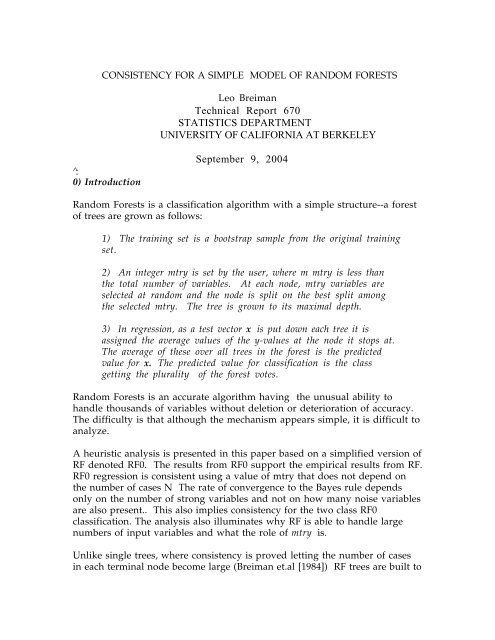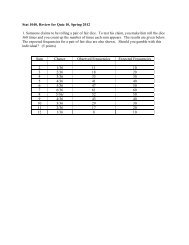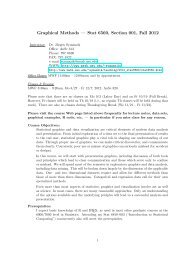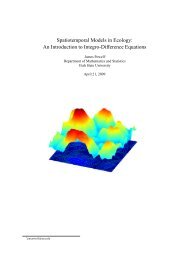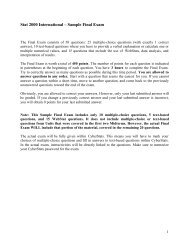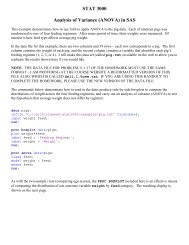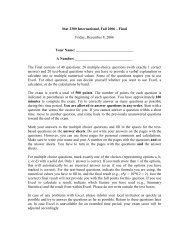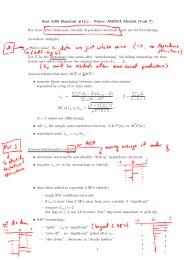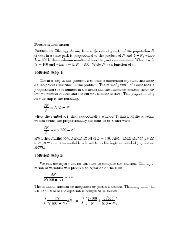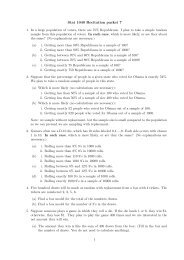Consistency for a Simple Model of Random Forests, Leo Breiman
Consistency for a Simple Model of Random Forests, Leo Breiman
Consistency for a Simple Model of Random Forests, Leo Breiman
You also want an ePaper? Increase the reach of your titles
YUMPU automatically turns print PDFs into web optimized ePapers that Google loves.
CONSISTENCY FOR A SIMPLE MODEL OF RANDOM FORESTS<strong>Leo</strong> <strong>Breiman</strong>Technical Report 670STATISTICS DEPARTMENTUNIVERSITY OF CALIFORNIA AT BERKELEY^:0) IntroductionSeptember 9, 2004<strong>Random</strong> <strong>Forests</strong> is a classification algorithm with a simple structure--a <strong>for</strong>est<strong>of</strong> trees are grown as follows:1) The training set is a bootstrap sample from the original trainingset.2) An integer mtry is set by the user, where m mtry is less thanthe total number <strong>of</strong> variables. At each node, mtry variables areselected at random and the node is split on the best split amongthe selected mtry. The tree is grown to its maximal depth.3) In regression, as a test vector x is put down each tree it isassigned the average values <strong>of</strong> the y-values at the node it stops at.The average <strong>of</strong> these over all trees in the <strong>for</strong>est is the predictedvalue <strong>for</strong> x. The predicted value <strong>for</strong> classification is the classgetting the plurality <strong>of</strong> the <strong>for</strong>est votes.<strong>Random</strong> <strong>Forests</strong> is an accurate algorithm having the unusual ability tohandle thousands <strong>of</strong> variables without deletion or deterioration <strong>of</strong> accuracy.The difficulty is that although the mechanism appears simple, it is difficult toanalyze.A heuristic analysis is presented in this paper based on a simplified version <strong>of</strong>RF denoted RF0. The results from RF0 support the empirical results from RF.RF0 regression is consistent using a value <strong>of</strong> mtry that does not depend onthe number <strong>of</strong> cases N The rate <strong>of</strong> convergence to the Bayes rule dependsonly on the number <strong>of</strong> strong variables and not on how many noise variablesare also present.. This also implies consistency <strong>for</strong> the two class RF0classification. The analysis also illuminates why RF is able to handle largenumbers <strong>of</strong> input variables and what the role <strong>of</strong> mtry is.Unlike single trees, where consistency is proved letting the number <strong>of</strong> casesin each terminal node become large (<strong>Breiman</strong> et.al [1984]) RF trees are built to
have a small number <strong>of</strong> cases in each terminal node. The driving <strong>for</strong>cebehind consistency is completely different. As the reader will see below itmostly resembles an adaptive nearest neighbor method that uses a smartdistance measure. This concept appeared first in a novel and interestingtechnical report by Jin and Jeon[2002].In this report, first the simple model RF0 is described. Then thecomputations are done from which consistency follows. The role <strong>of</strong> ntryis seen. Then remarks follow which point up the adaptive nature <strong>of</strong> theRF metric.1. The RF0 <strong>Model</strong>A. Some empirical resultsi) Omitting the bootstrapping <strong>of</strong> the training set has very little effect on theerror rate.ii) RF can have multiple cases in a single terminal node--i.e. all cases are <strong>of</strong>the same class. Using the medians <strong>of</strong> randomly selected variables to get toone case per terminal node has no effect on the error rate.iii) Splitting without using the class labels i.e. splitting at the medians <strong>of</strong> thevalues <strong>of</strong> a randomly selected variable at a node significantly increases theerror rate.These empirical results will be built into our simple model. Assume that thetraining data T={( y n,x n),n = 1,...,N} is i.i.d and the input vectors x have Mcoordinates. The M variables in RF0 are assumed uni<strong>for</strong>m and independent.( this is not a serious restriction and could be replaced by the assumption thatthe joint density is bounded above and below)Each variable x is associated with a probability p(m) which sum to one. Themconditional probability <strong>of</strong> each class, given x is linear in x and depends equallyon the "strong" variables only. If the sample size is large, then <strong>for</strong> strongvariables, the Gini criterion is minimized by a split at the center <strong>of</strong> the node.The splits by weak variables are random.The trees are constructed like this:i) At each node, a single variable is selected with the mthvariable having probability p(m) <strong>of</strong> being selected.ii) If the variable is strong, the split is at the midpoint <strong>of</strong> the <strong>of</strong>values if the selected variable at the node.
iii) If the variable is weak, the split is at a random point along itsvalues in the node.Assume the resulting tree is balanced, with each terminal node resultingfrom L = log 2N splits. Assume also that there is only one case per terminalnode (this can be in<strong>for</strong>ced by splitting on medians in the lower branches <strong>of</strong>the tree) Bootstrapping the training set is not done. The analysis will showthat the essential ingredient in consistency is the randomized selection <strong>of</strong>splitting variables at the nodes.The iid random vector Θ used to construct each tree is a collection <strong>of</strong>independent variables which select one item out <strong>of</strong> M items with probabilityp(m). Denote this collection <strong>for</strong> one tree by θ , other trees will be constructedusing independent copies <strong>of</strong> θ . For a single tree denote the rectanglecontaining x nby R(x n,θ).Let x be a test point and drop it down the tree. If it comes to rest in R(x n,θ)assign it the response value y n. As trees are built using other values <strong>of</strong> θ ,letQ(x,x n)=E θ(I(x∈R(x n,θ )Note that the sum <strong>of</strong> Q(x,x n) over n is one <strong>for</strong> all x.The <strong>for</strong>est estimate <strong>for</strong> y(x) isŷ(x)= ∑Q(x,x n) y n(1)nIt can be shown that 1-Q(x,z) is a Euclidean distance between x and z.There<strong>for</strong>e, (1) shows that RF is a classical nearest neighbor algorithm. As willbe seen, 1-Q(x,z) is a smart and adaptive metric. It can be shown that theclassical conditions <strong>for</strong> consistency are met. More will be done to get anestimate <strong>of</strong> how fast the Bayes rate is approached.Assume there are S strong variables and W weak variables, corresponding toS "large" values <strong>of</strong> p(m) equal to p S,W small values equal to p W, and thatE(y|x) depends only on the S strong variables (S and W are unknown).The Bayes estimate <strong>for</strong> y(x) is E(y|x). We will show that
E T(ŷ(x) ∫ −E(y|x)) 2 dx 1)goes to zero as the sample size increases, where E Tis the expectation withrespect to the training set., and that the rate <strong>of</strong> convergence depends only on Sand not on W.This pro<strong>of</strong> is <strong>for</strong> regression. But , as Devroye et.al. show, the rate <strong>of</strong>convergence to the Bayes rate <strong>for</strong> the two class classification problem is fasterthan the square root <strong>of</strong> 1)2 Decomposition into Variance and Biasŷ(x)= ∑ Q(x,x n)(y n−E(y|x n))+ ∑Q(x,x n) E(y|x n)nnThus, with the E Texpectation implicit in all terms,∫ (ŷ(x) −E(y|x)) 2 dx≤2 ∫ [ ∑ Q 2 (x,x n)(y n−E(y|x n))] 2 +n2[ ∫ ∑ Q(x,x n)(E(y|x)−E(y|x n))] 2nUsing familiar terminology the first term is referred to as variance V(N),, thesecond as bias B(N). Assume that E((y n−E(y|x n)) 2 ≤v. Then the varianceterm is initially bounded byv∫ ∑Q(x,x n) 2dx 2)n3. Bounding the VarianceThe bound on the variance is made possible by the randomization.Recall that Q(x,x n)=E θ(I(x∈R(x n,θ )). soQ(x,x n) 2 ≤E θE θ'I(x∈R(x n,θ )∩R(x n,θ'))where θ,θ' are independent outcomes <strong>of</strong> Θ. Then V(N) is bounded by:
∑ E θE θ'P(R(x n,θ )∩R(x n,θ' )).nThe rectangles are the product <strong>of</strong> m intervals J(m,θ ),J(m,θ') with∏ |J(m,θ ) |=1/ N ∏ |J(m,θ') |=1/ N .mmThe problem is to get a bound on V(θ,θ' )=The length|J(m,θ )| = 2 −n(m,θ )∏ |J(m,θ )∩J(m,θ') |.mwhere n(m,θ ) is the number <strong>of</strong> cuts by the mth variable leading to the<strong>for</strong>mation <strong>of</strong> the rectangle. This holds <strong>for</strong> the strong variables. It also holds<strong>for</strong> the expectation <strong>of</strong> the length <strong>for</strong> weak variables.The sum <strong>of</strong> the n(m,θ ) equals L. For the number <strong>of</strong> variables M largeenough, assume that the {n(m,θ )} are independent and have a binomialdistribution with L trials and probability p(m) <strong>of</strong> success. Clearly:and|J(m,θ )|∩J(m,θ')|≤2− max(n(m,θ ),n(m,θ'))Multiplying gives:2 − max(n(m,θ ),n(m,θ')) =2−n(m,θ )−[n(m,θ')−n(m,θ )]+V(θ,θ')≤ 1 2−[n(m,θ')−n(m,θ)]+∏N,mThe right hand side can be evaluated exactly (see appendix). The relevantresult is that if p(m)L is large, thenE θE θ'2 −[n(m,θ')−n(m,θ )]+ ≈1/πp(m)L
optimal per<strong>for</strong>mance . The advice given to users is to try several values <strong>of</strong>mtry and use the one that gives lowest cross-validated (oob) error rate.We examine the per<strong>for</strong>mance <strong>of</strong> this procedure when there are S strongvariables and W weak ones. Choose mtry variables from among the M atrandom with replacement--then choose the one that gives the best split.Assume all strong variables give equal results on the split. The same <strong>for</strong> allweak variables. If the selection is all weak, then choose one at random to spliton. If there is more than one strong variable selected in mtry, select one atrandom to split on.The probability that a variable in the W group will be chosen <strong>for</strong> a split is:In the S group, the probability is1W (W / M)mtry 5)1S (1−(W / M)mtry ) 6)At the optimal mtry the optimal p Swill be equal to 6). Assume W largecompared to S, thenmtry≈M /S(1+(4/3)S)Thus looking <strong>for</strong> an optimal mtry will give values <strong>of</strong> the probabilities <strong>for</strong>using the variables that are close to optimal computed as without knowingthe size <strong>of</strong> S and W. Note also that the optimal value <strong>of</strong> mtry does notdepend on N. Unlike kNN nearest neighbor where k must be increased withN to get optimal convergence, one value <strong>of</strong> mtry does <strong>for</strong> all sample sizes N.6 RemarksAs simplistic as the above model is, it goes far to clarify the behavior <strong>of</strong><strong>Random</strong> <strong>Forests</strong>. We see that it is an adaptive nearest neighbor azlgorithmwherei) The randomization works to reduce the variance.ii) It adapts to the loss function by having the narrowest widths in theterminal nodes corresponding to the largest components <strong>of</strong> the loss function.iii) It automatically adapts to the sample size.iv) The optimal value <strong>of</strong> mtry does not depend on the sample size.
A questionable part <strong>of</strong> RF0's definition is the assumption that with a linearloss function, the best cut by a strong variable will be at the center <strong>of</strong> the node.This is true only <strong>for</strong> nodes containing a large sample. Otherwise the cut willdepend more strongly on the individual values <strong>of</strong> the {y n}and theindependence property used to derive 2) is not applicable. Removing thisassumption makes a consistency pro<strong>of</strong> at least an order <strong>of</strong> magnitude moredifficult and involves ideas centered around the VC dimension.I am indebted to the Lin-Jeon technical report <strong>for</strong> suggestive insights that ledto some <strong>of</strong> the above conclusions.References<strong>Breiman</strong>, L. [2001] <strong>Random</strong> <strong>Forests</strong>, Machine Learning 45 5-32.<strong>Breiman</strong>, L. Friedman, J. Olshen, R. Stone, C[1984] "Classification andRegression Trees"Devroye, L, Gyorfi, L. Lugosi, G. "A Probabilistic Theory <strong>of</strong> PatternRecognition"Lin, Y. and Jeon, Y. [2002] <strong>Random</strong> <strong>for</strong>ests and Adaptive Nearest Neighbors.Technical Report 1005, Dept. Statistics, Univ. WisconsinAppendix (surely this must be known somewhere)Setwhere p=2 p(m)soϕ(z)=Ez n(m,θ')−n(m,θ )=( p(z+1/z)+1− p) LP(n(m,θ')−n(m,θ )=k)= 1 ∫ ϕ(z) z −k−1 dz2πi∑ 2 −k P(n(m,θ')−n(m,θ )=k)= 1k≥02πi∫ ϕ(z) z −1 /(1−(1/2z))dzSubstituting z=e iθ in the right hand side and doing simplification gives1 (2−cosθ )∫ (1−2 psin 2 (θ /2)) L dθπ (5−4cosθ )
The results stated above <strong>for</strong> large and small p can be derived from thisintegral.


